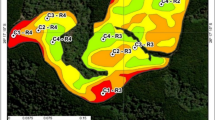Abstract—
After the accident at the Fukushima Daiichi Nuclear Power Plant, an increased frequency of cancellation of the apical dominance has been revealed in young pine trees. The detected morphoses are most likely to result from radiation damage to the apical meristems of the conifers and also from changes in their phytohormonal status. To test this hypothesis, we have checked Japanese red pine populations from areas contaminated with radionuclides after the Fukushima accident for the frequency of morphoses related to cancellation of the apical dominance and estimated the content of main phytohormone classes: indoleacetic acid (IAA), indolylbutyric acid (IBA), zeatin, gibberellic acid (GA), and abscisic acid (ABA). The concentrations of phytohormones in the needles of young trees (5–8 years) were determined by high performance liquid chromatography. It has been shown for the first time that chronic radiation exposure changes the ratio of the main phytohormone classes in the needles of Japanese red pine: the concentrations of IAA, zeatin, and ABA increase, while the concentrations of GA decreases. The results have allowed us to explain the phenomenon of the increased frequency of cancellation of the apical dominance in the populations of young conifer trees from the zone of the Fukushima accident.






Similar content being viewed by others
REFERENCES
Steinhauser, G., Brandl, A., and Johnson, T.E., Comparison of the Chernobyl and Fukushima nuclear accidents: A review of the environmental impacts, Sci. Tot. Environ., 2014, vols. 470–471, pp. 800–817. https://doi.org/10.1016/j.scitotenv.2013.10.029
Hashimoto, S., Ugawa, S., Nanko, K., et al., The total amounts of radioactively contaminated materials in forests in Fukushima, Japan, Sci. Rep., 2012, vol. 2, 416. https://doi.org/10.1038/srep00416
Watanabe, Y., Ichikawa, S., Kubota, M., et al., Morphological defects in native Japanese fir trees around the Fukushima Daiichi Nuclear Power Plant, Sci. Rep., 2015, vol. 5, 13232. https://doi.org/10.1038/srep13232
Yoschenko, V., Nanba, K., Yoshida, S., et al., Morphological abnormalities in Japanese red pine (Pinus densiflora) at the territories contaminated as a result of the accident at Fukushima Dai-Ichi Nuclear Power Plant, J. Environ. Radioact., 2016, vol. 165, pp. 60–67. https://doi.org/10.1016/j.jenvrad.2016.09.006
Lutova, L.A., Ezhova, T.A., Dodueva, I.E., and Osipova, M.A., Genetika razvitiya rastenii (Genetics of Plant Development), St. Petersburg: Nauka, 2010.
ICRP Publication 103: The 2007 Recommendations of the International Commission on Radiological Protection, Annals of the ICR, vol. 37, Elsevier, 2007.
Bitarishvili, S.V., Volkova, P.Yu., and Geras’kin, S.A., γ-Irradiation of barley seeds and its effect on the phytohormonal status of seedlings, Russ. J. Plant Physiol., 2018, vol. 65, n. 3, pp. 446–454. https://doi.org/10.1134/S1021443718020024
Vishwakarma, K., Upadhyay, N., Kumar, N., et al., Abscisic acid signaling and abiotic stress tolerance in plants: A review on current knowledge and future prospects, Front. Plant Sci., 2017, vol. 8, 161. https://doi.org/10.3389/fpls00161
Bitarishvili, S.V., Pishenin, I.A., Shesterikova, E.M., and Volkova, P.Yu., Abscisic acid contents in herbaceous plant populations exposed to chronic radiation impact, in Sovremennye problemy radiobiologii, radioekologii i agroekologii (Current Problems in Radiobiology, Radioecology, and Agroecology), Obninsk, 2019, p. 26.
Mounir, A.M., El-Yazid, A.A., Orabi, I.O.A., et al., Effect of sowing date, gamma irradiation and intercultivar differences on growth, pod characteristics and some endogenous plant growth regulators in snap beans, World J. Agric. Sci., 2015, vol. 11, pp. 380–390. https://doi.org/10.5829/idosi.wjas.2015.11.6.1891
Woodward, A.W. and Bartel, B., Auxin: Regulation, action, and interaction, Ann. Bot., 2005, vol. 95, pp. 707–735. https://doi.org/10.1093/aob/mci083
Strader, L.C., Culler, A.H., Cohen, J.D., and Bartel, B., Conversion of endogenous indole-3-butyric acid to indole-3-acetic acid drives cell expansion in arabidopsis seedlings, Plant Physiol., 2010, vol. 153, pp. 1577–1586. https://doi.org/10.1104/pp.110.157461
Jasinski, S., Piazza, P., Craft, J., et al., KNOX action in Arabidopsis is mediated by coordinate regulation of cytokinin and gibberellin activities, Curr. Biol., 2005, vol. 15, pp. 1560–1565. https://doi.org/10.1016/j.cub.2005.07.023
Kozubov, G.M. and Taskaev, A.I., Specific features of morphogenesis and growth processes in conifers in the region of the Chernobyl accident, Radiat. Biol. Radioekol., 2007, vol. 47, no. 2, pp. 204–223.
Ha, S., Vankova, R., Yamaguchi-Shinozaki, K., et al., Cytokinins: Metabolism and function in plant adaptation to environmental stresses, Trends Plant Sci., 2012, vol. 17, pp. 172–179. https://doi.org/10.1016/j.tplants.2011.12.005
Nishiyama, R., Watanabe, Y., Fujita, Y., et al., Analysis of cytokinin mutants and regulation of cytokinin metabolic genes reveals important regulatory roles of cytokinins in drought, salt and abscisic acid responses, and abscisic acid biosynthesis, Plant Cell, 2011, vol. 23, pp. 2169–2183. https://doi.org/10.1105/tpc.111.087395
Pavlu, J., Novak, J., Koukalova, V., et al., Cytokinin at the crossroads of abiotic stress signaling pathways, Int. J. Mol. Sci., 2018, vol. 19, 2450. https://doi.org/10.3390/ijms19082450
Gudkov, I.N., Osnovy obshchei i sel’skokhozyaistvennoi radiobiologii (Fundamentals of General and Agricultural Radiobiology), Kiev: USKhA, 1991.
Funding
This study was supported by the Russian Foundation for Basic Research (project no. 119-54-50003) and by the JSPS grant within the framework of the bilateral program of RFBR–JSPS joint projects.
Author information
Authors and Affiliations
Corresponding author
Additional information
Translated by D. Zabolotny
Rights and permissions
About this article
Cite this article
Bitarishvili, S.V., Geras’kin, S.A., Yoschenko, V.I. et al. Change in the Phytohormonal Status of Japanese Red Pine after the Fukushima Accident. Russ J Ecol 52, 109–117 (2021). https://doi.org/10.1134/S1067413621020041
Received:
Revised:
Accepted:
Published:
Issue Date:
DOI: https://doi.org/10.1134/S1067413621020041




